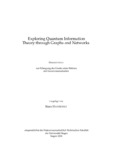Citation link:
http://dx.doi.org/10.25819/ubsi/10591Files in This Item:
| File | Description | Size | Format | |
|---|---|---|---|---|
| Dissertation_Hansenne_Kiara.pdf | 13.47 MB | Adobe PDF |  View/Open |
| Dokument Type: | Doctoral Thesis | metadata.dc.title: | Exploring quantum information theory through graphs and networks | Other Titles: | Untersuchung der Quanteninformationstheorie anhand von Graphen und Netzwerken | Authors: | Hansenne, Kiara | Institute: | Department Physik | Free keywords: | Quantum information theory, Quantum entanglement, Quantum networks, Uncertainty relations, Quantum state tomography, Quanteninformationstheorie, Quantenverschränkung, Quantennetzwerke, Unsicherheitsbeziehungen, Quantenzustands-Tomographie | Dewey Decimal Classification: | 530 Physik | Issue Date: | 2024 | Publish Date: | 2024 | Abstract: | In this manuscript, we explore different aspects of quantum information using graph theory as a principal tool. The research presented in this thesis addresses fundamental questions in quantum information theory, such as uncertainty relations and quantum entanglement, as well as practical applications such as certification of quantum systems. First, we define and analyse the anticommutativity graph associated with a set of observables. This approach allows us to relate the expectation values of these observables to the Lovász number of their anticommutativity graph, a well-known graph invariant. More specificity, the Lovász number provides an upper bound on the sum of the squares of the expectation values. This relationship enables us to derive uncertainty relations for any set of dichotomic observables. These can be transformed into witnesses to detect entanglement, including in PPT entangled states. Second, we address the problem of measurement scheduling for marginal state tomography, i.e., finding measurement settings that allow for the reconstruction of marginal states of a quantum system. We demonstrate that, for Pauli tomography, this problem can be mapped to a specific instance of the graph-theoretical problem of edge clique covering. Using this mapping, we show for instance that, for two-body marginal tomography of planar qubit topologies, nine Pauli settings are necessary and sufficient, regardless of the numbers of qubits in the system. Furthermore, we establish that with general local projective measurements, 3^k measurement settings are sufficient to reconstruct all k-body marginal states of a multi-qubit system. We report an experimental demonstration of the applicability of the measurement settings derived in our work. Lastly, we develop necessary criteria for network entanglement, revealing that many graph states, as well as permutationally symmetric states, cannot be prepared in network structures without the usage of classical communication. We then propose a certification protocol for the topology of quantum networks, which has later been implemented experimentally. In dieser Arbeit werden verschiedene Aspekte der Quanteninformation unter Verwendung der Graphentheorie als Hauptwerkzeug untersucht. Die vorliegende Studie befasst sich sowohl mit grundlegenden Fragen der Quanteninformationstheorie, wie Unschärferelationen und Quantenverschränkung, als auch mit praktischen Anwendungen, beispielsweise der Zertifizierung von Quantensystemen. Erstens definieren und analysieren wir den Antikommutativitätsgraph, der mit einer Menge von Observablen verbunden ist. Dieser Ansatz ermöglicht es uns, die Erwartungswerte dieser Observablen mit der Lovász-Zahl des Graphen, einer bekannten Grapheninvariante, in Beziehung zu setzen. Die Lovász-Zahl liefert eine obere Schranke an die Summe der Quadrate der Erwartungswerte. Aus dieser Beziehung lassen sich Unschärferelationen für beliebige dichotome Observablen ableiten, die wiederum zum Nachweis verschränkter Zustände, einschließlich PPT-verschränkter Zustände, verwendet werden können. Im zweiten Teil der Arbeit befassen wir uns mit der optimalen Messstrategie für Marginalzustands-Tomographie. Wir zeigen, dass dieses Problem im Fall der Pauli-Tomographie auf einen Spezialfall des graphentheoretischen Problems der Kanten-Cliquen-Abdeckung reduziert werden kann. Mit Hilfe dieser Methode demonstrieren wir zum Beispiel, dass für die Zweikörper-Marginal-Tomographie von planaren Qubit-Topologien neun Pauli-Einstellungen ausreichen, unabhängig von der Anzahl der Qubits im System. Zudem zeigen wir, dass bei allgemeinen lokalen projektiven Messungen 3^k Messeinstellungen genügen, um alle k-Körper-Marginalzustände eines Multiqubit-Systems zu rekonstruieren. Die Anwendbarkeit unserer Messeinstellungen wurde experimentell überprüft. Zuletzt entwickeln wir notwendige Kriterien für Netzwerkverschränkung und zeigen, dass viele Graphenzustände sowie alle permutationssymmetrischen Zustände in Netzwerkstrukturen ohne klassische Kommunikation nicht erzeugt werden können. Anschließend schlagen wir ein Zertifizierungsprotokoll für die Topologie von Quantennetzwerken vor und präsentieren hiervon eine experimentelle Implementierung. |
DOI: | http://dx.doi.org/10.25819/ubsi/10591 | URN: | urn:nbn:de:hbz:467-28113 | URI: | https://dspace.ub.uni-siegen.de/handle/ubsi/2811 |
| Appears in Collections: | Hochschulschriften |
This item is protected by original copyright |
Page view(s)
95
checked on Nov 30, 2024
Download(s)
58
checked on Nov 30, 2024
Google ScholarTM
Check
Altmetric
Items in DSpace are protected by copyright, with all rights reserved, unless otherwise indicated.

